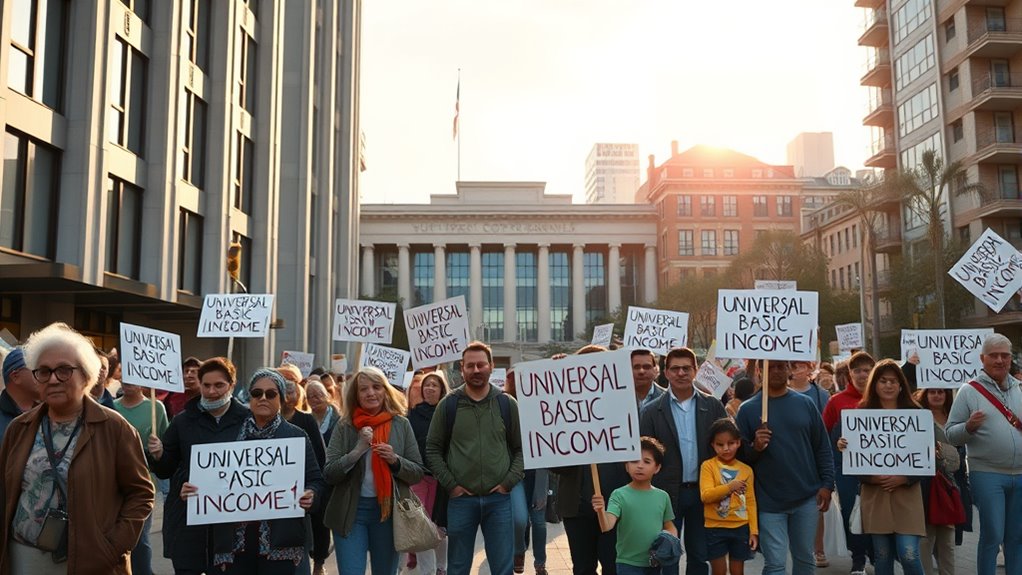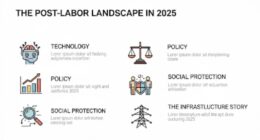Universal Basic Income can help narrow the wealth gap by providing everyone with a guaranteed income, which boosts financial security and promotes upward mobility. It redistributes resources from wealthier groups to lower-income households, reducing economic disparities. While implementation challenges exist, many pilot programs show UBI’s potential to improve well-being and promote equality across various communities. By understanding how funding and policy design influence outcomes, you’ll discover more ways UBI can shape a fairer future.
Key Takeaways
- UBI redistributes income from wealthier to lower-income groups, reducing overall wealth disparities.
- Pilot programs show significant wealth gains for marginalized and historically underserved communities.
- Universal basic income helps narrow racial and ethnic wealth gaps through targeted allocations.
- By providing financial stability, UBI enables investments in education and entrepreneurship, promoting upward mobility.
- Funding mechanisms and progressive taxation are crucial for UBI’s effectiveness in reducing economic inequality.
How Universal Basic Income Reduces Poverty Worldwide

Have you ever wondered how providing a basic income to everyone can help reduce poverty worldwide? When you receive a guaranteed income, you can meet your basic needs more easily. UBI offers financial stability, allowing you to plan ahead and invest in your future. Studies show that recipients often become more productive because they have the security to engage in economic activities without constant worry. Additionally, UBI improves health by reducing stress and increasing access to healthcare. Many UBI trials, like those in India and Namibia, have shown positive results, including empowered women, better food access, and decreased dependency. Overall, UBI simplifies social support systems, making it easier to lift many out of poverty and provide a basic level of economic security for all. Incorporating social safety nets can also enhance the effectiveness of UBI by providing additional targeted support. Regular maintenance of disbursement systems ensures timely and reliable delivery of benefits to recipients. Moreover, integrating financial literacy programs can help recipients make the most of their income and foster long-term economic stability. To maximize impact, public awareness campaigns are essential for educating the public about the benefits and proper use of UBI.
The Relationship Between UBI and Income Disparities

Universal Basic Income (UBI) plays a significant role in shaping income disparities across different socio-economic groups. By providing a safety net, UBI aims to redistribute income, helping to reduce gaps between the wealthy and the poor. It promotes economic equality by offering financial security to all, regardless of background. Additionally, UBI can lessen gender inequality by supporting unpaid work like childcare and elder care, empowering women financially. It also influences work incentives, encouraging people to seek meaningful jobs rather than just any employment. The impact on income disparities depends on how UBI is funded and integrated into existing social systems. Properly structured, UBI can help narrow income gaps and foster a fairer economic landscape. Research indicates that UBI can effectively address coverage issues and poverty, making it a potentially transformative tool for economic equality.
Economic Challenges and Opportunities of Implementing UBI

Implementing UBI presents both significant opportunities and complex challenges that must be carefully navigated. You’ll face concerns about job market impacts, as some believe UBI might reduce workforce participation, lowering economic output and tax revenue. While UBI can help address technological unemployment, jobs are evolving, not disappearing. Funding poses a major challenge; for example, a $12,000 annual UBI in the U.S. would cost around $2.4 trillion annually. Additionally, integrating UBI with existing social programs risks benefit cliffs and system conflicts. Implementing UBI also requires careful consideration of administrative capacity. Scalability is another hurdle, given the high costs and logistics involved. However, opportunities exist in stimulating local economies, fostering innovation, reducing poverty, and promoting financial stability. Understanding the complexities of social behaviors and incentives is crucial to designing effective UBI policies, as behavioral responses can significantly impact outcomes. With careful planning, UBI could contribute to long-term economic growth and greater equality.
The Role of Funding Strategies in UBI Effectiveness

Funding strategies play a crucial role in determining how effective UBI can be in promoting economic stability and reducing inequality. Your choice of funding sources influences who benefits and how efficiently resources are allocated. Adequate funding is essential for the sustainability of UBI programs, ensuring that transfers are reliable and can be scaled to meet community needs. Tapping into state resources from natural assets or industries offers a sustainable funding option. Streamlining existing welfare programs can reduce administrative costs and free up funds for UBI. The success of UBI depends on balancing these strategies to ensure funding is sufficient and targeted appropriately. Efficient resource allocation is vital to maximize the impact of UBI and ensure long-term success. Inefficient or poorly structured funding can limit UBI’s impact, making it vital to choose the right mix of revenue sources for long-term effectiveness. Additionally, considering funding strategies rooted in diverse economic sectors can help build resilience against market fluctuations. For example, leveraging natural resource revenues can provide a stable and sustainable income stream to support UBI programs. Proper planning and financial management are essential to prevent resource depletion and ensure ongoing support for the program. Moreover, understanding aura and its implications on individual well-being can contribute to holistic approaches in designing social safety nets.
Impact of UBI on Wealth Concentration and Distribution

Universal Basic Income can shift wealth by redistributing funds from the rich to the poor, helping to reduce economic gaps. You’ll see lower-income groups benefit most, with some impact on overall inequality measures. Additionally, the effectiveness depends on how the program is designed and financed. Implementing protective styling benefits in UBI schemes can further enhance social stability and economic resilience. Furthermore, understanding how color accuracy impacts overall image quality can inform the design of more equitable economic policies. Incorporating vetted dog names into social programs could also serve as a way to foster community identity and engagement. Recognizing the importance of fatherhood in shaping character can inspire more compassionate and supportive social initiatives.
Wealth Redistribution Effects
UBI has the potential to considerably alter wealth distribution by shifting resources from the wealthy to those with lower incomes. This redistribution depends heavily on funding mechanisms like higher taxes on the rich and progressive systems such as VAT. You’ll see a more balanced resource spread, reducing wealth concentration. Additionally, implementing vertical storage solutions can optimize the use of space and resources, reinforcing the broader goal of equitable resource allocation. As AI security technologies advance, they can also support fair resource distribution by ensuring transparency and fairness in allocation processes. Moreover, promoting practices like sleep and mental health can improve overall well-being, making support systems more effective in reducing disparities. Incorporating innovative materials into resource management infrastructure can further enhance efficiency and sustainability in distribution systems. Proper filtration and pump protection in resource management systems can further ensure the integrity of the distribution infrastructure.
Narrowing Income Disparities
By redistributing wealth more evenly, UBI can play a significant role in narrowing income disparities and reducing wealth concentration. For example, a $1,000 monthly UBI raises median wealth for White families from $115,103 to $119,425, while a $2,000 payment boosts it to $127,505. For Black families, the same payments nearly double median wealth—from $17,853 to $34,183 with $1,000, and to $48,310 with $2,000—highlighting a disproportionate benefit for historically marginalized groups. This proportional growth indicates UBI’s potential to reduce racial wealth gaps, especially for lower-wealth households. When designed effectively, UBI can offer targeted support that lowers income inequality, making the distribution more equitable across different racial and economic groups.
Lessons From Global UBI Pilot Programs

Examining global pilot programs reveals valuable lessons about implementing basic income initiatives effectively. You see that different countries experiment with various funding models, such as government budgets, natural resources, or private donations. Some pilots target unemployed individuals, while others focus on entire communities or those in poverty. Duration matters too: short-term pilots boost well-being but often lack long-term economic impact. Additionally, some programs explore Gold IRA options to fund or sustain initiatives, highlighting innovative financial strategies.
Key lessons include:
- Limited employment effects: Most pilots show little change in employment rates but promote financial stability.
- Health and social benefits: Recipients report better mental health, nutrition, and housing security.
- Funding and political hurdles: High costs and bureaucratic challenges often hinder program continuity and expansion.
These insights help shape future UBI efforts, highlighting what’s feasible and what needs improvement.
Policy Design Considerations for Narrowing the Wealth Gap

Designing effective policies to narrow the wealth gap requires careful integration of UBI within broader social protection systems. You should consider how the payment structure influences inequality, guaranteeing it benefits lower-income groups without favoring higher earners. Needs-based adjustments, like support for childcare or disabilities, can target resources more efficiently. Funding mechanisms are vital; raising taxes or redirecting existing funds can impact redistribution efforts. Decide whether UBI will be universal or targeted, as this choice affects both resource allocation and inequality reduction. You must also guarantee UBI complements other social programs to maximize impact. Without thoughtful integration and strategic design, UBI risks being less effective at narrowing the wealth gap, emphasizing the importance of comprehensive planning to achieve meaningful socioeconomic improvements. Additionally, understanding the Community context can inform the design of social policies that foster community stability and well-being. Furthermore, considering the equity implications in policy design ensures that benefits are distributed fairly across different socioeconomic groups. Incorporating mental wellbeing considerations can also enhance the overall effectiveness of these initiatives. Recognizing the role of targeted interventions, such as education and job training, can further amplify the impact of UBI on reducing inequality.
Future Perspectives on UBI and Socioeconomic Equality

The future of UBI holds promising potential for advancing socioeconomic equality, especially as it addresses core issues like poverty and financial insecurity. By providing a guaranteed income floor, UBI can help reduce disparities and support physical and mental health. As automation and job displacement grow, UBI offers a resilient safety net for vulnerable populations. Looking ahead, UBI could:
- Narrow racial and ethnic wealth gaps through targeted cash allocations and systemic reforms
- Promote long-term equality by enabling access to education, healthcare, and housing
- Encourage upward mobility by giving recipients the stability to invest in skills, entrepreneurship, or better jobs
Additionally, integrating Ring Security Cameras could improve community safety and help monitor the effects of UBI implementation at the local level. However, challenges remain, including funding, potential impacts on labor, and the need for complementary reforms. Sustained political support is essential to realize UBI’s full potential for societal equity.
Frequently Asked Questions
How Does UBI Affect Local Economies Beyond Poverty Reduction?
You might wonder how UBI impacts local economies beyond just reducing poverty. When you provide a steady income, you boost local spending, which supports businesses and creates jobs. Increased demand encourages entrepreneurs and small firms to expand. UBI also fosters social stability, reducing inequality and stigma. As a result, communities become more vibrant and resilient, with higher economic activity and improved social cohesion, benefiting everyone in the area.
What Are the Long-Term Societal Impacts of Widespread UBI Adoption?
You might notice that widespread UBI adoption can lead to profound societal changes over time. It could boost community engagement, enhance social mobility, and foster a more balanced lifestyle by shifting norms around work and leisure. Additionally, it might support arts and education, improve mental and physical health, and reduce social stigma. However, you’ll also need to contemplate challenges like funding sustainability and regional disparities to fully realize these long-term benefits.
Can UBI Replace Existing Social Welfare Programs Effectively?
Imagine a bridge connecting two islands—steady, simple, yet potentially unstable. When you ask if UBI can replace existing social welfare programs, the answer is complex. It might streamline support and reduce bureaucracy, but full replacement faces hurdles like political resistance, fiscal strain, and the need for targeted aid. Without careful planning, you risk leaving vulnerable populations behind, much like a bridge that’s incomplete or poorly maintained.
How Do Cultural Differences Influence UBI Acceptance Globally?
You see that cultural differences shape how people view UBI worldwide. In societies with strong work ethics, support drops because folks value paid employment highly. Conversely, countries less attached to work are more open to UBI trials. Cultural norms, like the importance placed on work and social cohesion, influence acceptance levels. These variations explain why some nations embrace UBI while others resist, depending on their cultural attitudes toward work and social welfare.
What Are Potential Unintended Consequences of Implementing UBI at Scale?
You might find that implementing UBI at scale leads to unintended consequences. It could reduce your motivation to work, causing labor shortages and slowing economic growth. You may also see increased government spending, risking higher taxes or inflation. Socially, it might create dependency or weaken community engagement, especially if support replaces targeted aid. Policy design challenges could result in gaps or unfair distribution, impacting vulnerable groups and overall societal stability.
Conclusion
As you consider UBI’s potential, remember it’s like planting seeds for a fairer future—nurturing hope and opportunity where inequality once took root. While challenges exist, thoughtful implementation can help bridge the wealth gap and create a more equal society. Your support and understanding can turn the promise of UBI into a beacon of change, illuminating a path toward economic justice that benefits everyone, not just the privileged few.









